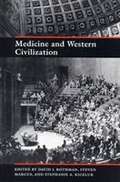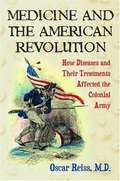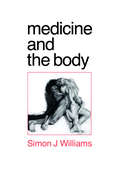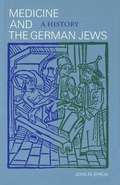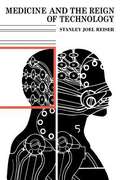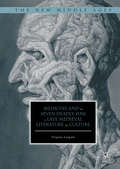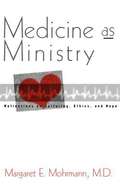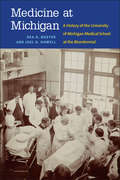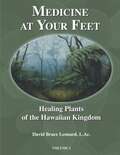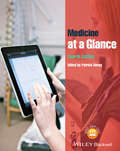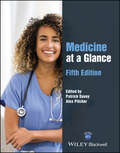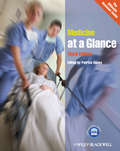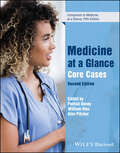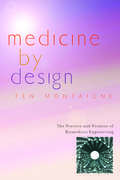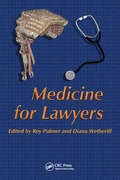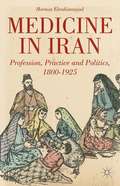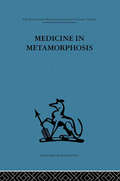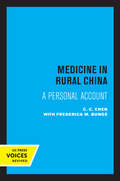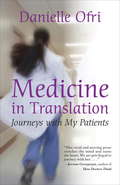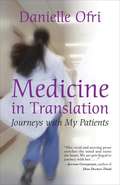- Table View
- List View
Medicine and Western Civilization
by David J. Rothman Steven Marcus Stephanie A. KicelukHowever, the brief background material for the selections center around the authors and offer little or no discussion about the selections' relevance to the topics at hand. This book would be best read in a class or group where the texts' meaning in relation to each other can be discussed, but the book can stand alone if the reader is prepared to do some critical thinking.
Medicine and the American Revolution: How Diseases and Their Treatments Affected the Colonial Army
by Oscar ReissNearly nine times as many died from diseases during the American Revolution as did from wounds. Poor diet, inadequate sanitation and sometimes a lack of basic medical care caused such diseases as dysentery, scurvy, typhus, smallpox and others to decimate the ranks. Scurvy was a major problem for both the British and American navies, while venereal diseases proved to be a particularly vexing problem in New York. Respiratory diseases, scabies and other illnesses left nearly 4,000 colonial troops unable to fight when George Washington's troops broke camp at Valley Forge in June 1778. From a physician's perspective, this is a unique history of the American Revolution and how diseases impacted the execution of the war effort. The medical histories of Washington and King George III are also provided.
Medicine and the Body
by Prof Simon Johnson WilliamsThis is a clear, well-written account of medicine, health and the body. Taking recent debates on the body and society as its point of departure, the book critically reexamines a series of embodied issues and emotional agendas in health and illness. Included here are cutting edge discussions and debates concerning: <p><p> - the medicalized body - health inequalities - childhood and ageing - the dilemmas of high-tech medicine - chronic illness and disability - caring and (bio)ethics - sleep, death and dying - the body in late/postmodernity <p> Written in an accessible, engaging style, with many original and innovative insights, the book will appeal to undergraduate and postgraduate students alike, and to researchers and lecturers with an interest in the embodied agendas of health and medicine in the new millennium.
Medicine and the German Jews: A History
by John M. EfronMedicine played an important role in the early secularization and eventual modernization of German Jewish culture. And as both physicians and patients, Jews exerted a great influence on the formation of modern medical discourse and practice. This fascinating book investigates the relationship between German Jews and medicine from medieval times until its demise under the Nazis. John Efron examines the rise of the German Jewish physician in the Middle Ages and his emergence as a new kind of secular, Jewish intellectual in the early modern period and beyond. The author shows how nineteenth-century medicine regarded Jews as possessing distinct physical and mental pathologies, which in turn led to the emergence in modern Germany of the "Jewish body" as a cultural and scientific idea. He demonstrates why Jews flocked to the medical profession in Germany and Austria, noting that by 1933, 50 percent of Berlin's and 60 percent of Vienna's physicians were Jewish. He discusses the impact of this on Jewish and German culture, concluding with the fate of Jewish doctors under the Nazis, whose assault on them was designed to eliminate whatever intimacy had been built up between Germans and their Jewish doctors over the centuries. --BOOK JACKET. Title Summary field provided by Blackwell North America, Inc. All Rights Reserved
Medicine and the Market: Equity v. Choice (Bioethics)
by Daniel Callahan Angela A. WasunnaOutstanding Academic Title for 2007, Choice MagazineMuch has been written about medicine and the market in recent years. This book is the first to include an assessment of market influence in both developed and developing countries, and among the very few that have tried to evaluate the actual health and economic impact of market theory and practices in a wide range of national settings.Tracing the path that market practices have taken from Adam Smith in the eighteenth century into twenty-first-century health care, Daniel Callahan and Angela A. Wasunna add a fresh dimension: they compare the different approaches taken in the market debate by health care economists, conservative market advocates, and liberal supporters of single-payer or government-regulated systems. In addition to laying out the market-versus-government struggle around the world—from Canada and the United States to Western Europe, Latin America, and many African and Asian countries—they assess the leading market practices, such as competition, physician incentives, and co-payments, for their economic and health efficacy to determine whether they work as advertised. This timely and necessary book engages new dimensions of a development that has urgent consequences for the delivery of health care worldwide.
Medicine and the Reign of Technology
by Stanley Joel ReiserBased chiefly on material from primary sources, this book describes some technological advances made in the art and practice of medicine during the past three centuries and shows how these advances have altered the methods of diagnosing illness.
Medicine and the Saints: Science, Islam, and the Colonial Encounter in Morocco, 1877-1956.
by Ellen J. AmsterThe colonial encounter between France and Morocco took place not only in the political realm but also in the realm of medicine. Because the body politic and the physical body are intimately linked, French efforts to colonize Morocco took place in and through the body. Starting from this original premise, Medicine and the Saints traces a history of colonial embodiment in Morocco through a series of medical encounters between the Islamic sultanate of Morocco and the Republic of France from 1877 to 1956. Drawing on a wealth of primary sources in both French and Arabic, Ellen Amster investigates the positivist ambitions of French colonial doctors, sociologists, philologists, and historians; the social history of the encounters and transformations occasioned by French medical interventions; and the ways in which Moroccan nationalists ultimately appropriated a French model of modernity to invent the independent nation-state. Each chapter of the book addresses a different problem in the history of medicine: international espionage and a doctor’s murder; disease and revolt in Moroccan cities; a battle for authority between doctors and Muslim midwives; and the search for national identity in the welfare state. This research reveals how Moroccans ingested and digested French science and used it to create a nationalist movement and Islamist politics, and to understand disease and health. In the colonial encounter, the Muslim body became a seat of subjectivity, the place from which individuals contested and redefined the political.
Medicine and the Seven Deadly Sins in Late Medieval Literature and Culture
by Virginia LangumThis book considers howscientists, theologians, priests, and poets approached the relationship of thehuman body and ethics in the later Middle Ages. Is medicine merely a metaphorfor sin? Or can certain kinds of bodies physiologically dispose people to beangry, sad, or greedy? If so, then is it their fault? Virginia Langum offers anaccount of the medical imagery used to describe feelings and actions inreligious and literary contexts, referencing a variety of behavioraldiscussions within medical contexts. The study draws upon medical andtheological writing for its philosophical basis, and upon more popular works ofreligion, as well as poetry, to show how these themes were articulated,explored, and questioned more widely in medieval culture.
Medicine as Ministry: Reflections on Suffering, Ethics, and Hope
by Margaret E. MohrmanIn this profoundly theological reflection on illness, healing, and the doctor-patient relationship, pediatrician Margaret Mohrmann bridges the sometimes disparate worlds of medicine and faith, of high technology and ultimate concern. Drawing on her two decades of experience treating children who suffer from disease and dysfunction, Mohrmann movingly reveals the temptations of idolatry that beset our understanding of health and life, the intrinsic connectedness underlying all medical encounters, and the difficulties and riches of using scripture as a moral resource. In clear, accessible language Mohrmann emphasizes the importance of interpreting the lives of the suffering as meaningful and ongoing stories - stories that require all of us to respond in healing ways. Uncovering insights from such diverse sources as the apostle Paul, Alasdair MacIntyre and Flannery O'Connor, she suggests that what is required for a truly human life is not the absence of pain, but the presence of others. Both pastoral and prophetic, Medicine as Ministry is a challenge to rethink the purposes of health care - and to better discern the human condition.
Medicine as a Scholarly Field: An Introduction
by O. S. MiettinenThis book exposes, and fills, a notable void in the educational content generally covered in modern schools of medicine. It provides an introduction to the field at large in terms of content that is relevant for each of the specialties and subspecialties of medici≠ and to this end, it addresses the modern counterpart of the Hippocratic philosophy that was at the root of the genesis of modern medicine. The much-needed but still-missing introductory content for the interdisciplinary 'medical common,' provided in this book, addresses mainly the most elementary concepts and principles of medicine. Those concepts flow, hierarchically, from the essence of (health and) ill-health/illness for one and that of medicine for another, both of these critically formulated; and those principles are dictates of logic and ethics, both specific to medicine. While a modern physician is expected to be competent as a scholar in his/her particular discipline of medicine, study of this book is essential for the development of that competence -- for learning, for example, to make a tenable distinction between scientific medicine and medical science, and between knowledge-based medicine (scientific and other) and its opinion-based substitutes ('evidence-based' and other). "To me it is astonishing and to medicine actually shameful that it has taken up to year 2015 before there is a work in which the essence of medicine is described and discussed. " -- J. Steurer, University of Zurich "[In this book], Miettinen beautifully elucidates the concepts and principles of knowledge-based diagnosis, and prognosis, within medicine. Now, after six decades of keen observation and study, and critical reflection on medicine and medical research, Miettinen, in this book, shares the fundamental understandings he has reached; . . . " -- T. J. VanderWeele, Harvard University "The aim of this book . . . is admirable. The composition of the book -- from the key concepts to logical and ethical principles -- is very clear and systematic. I am convinced that this kind of book is needed. " -- I. Niiniluoto, University of Helsinki
Medicine at Michigan: A History of the University of Michigan Medical School at the Bicentennial
by Dea Boster Joel D. HowellA trailblazer in American medical education since 1850, the Medical School at the University of Michigan was the first program in the United States to own and operate its own hospital and the earliest major medical school to admit women. In the late nineteenth century, the School emerged as a frontrunner in modern scientific medical education in the United States, and one of the first in the nation to implement both required clinical clerkships and laboratory science as part of their curriculum, including the first full laboratory course in bacteriology. Decades later, the Medical School remained at the vanguard of medical education by increasing its focus on research, and these efforts resulted in world-changing breakthroughs such as field-testing the first safe polio vaccine, proposing a genetic mechanism for sickle cell anemia, inventing the fiber-optic endoscope, and cloning the gene responsible for cystic fibrosis. The Medical School’s history is not without its growing pains: alongside top-tier education and incredible innovation came times of stress with the broader University and Ann Arbor communities, complex expectations and realities for student diversity, and many controversies over curriculum and methodology. Medicine at Michigan explores how the School has dealt with changes in medical science, practice, and social climates over the past 150 years and illuminates the complicated interactions between economic, social, and cultural trends and medical education at the University of Michigan and across the nation. This book will appeal to readers interested in the history of medicine as well as current and former medical faculty members, students, and employees of the University of Michigan Medical School.
Medicine at Your Feet: Healing Plants of the Hawaiian Kingdom
by David Bruce Leonard L.Ac.A Hawaii-based practitioner of traditional Chinese medicine, David Bruce Leonard, has completed Medicine at Your Feet: Healing Plants of the Hawaiian Kingdom. Taking ten years to complete, this first volume is one of the most authoritative sources of information on Hawaiian medicinal plants. Exhaustively researched, Medicine at Your Feet contains cross-cultural uses for 49 different Hawaiian plant medicines, many of which are easy to find. Included is information on medicinal properties, food uses, chemical constituents, herbal combinations, plant gathering protocols, possible drug interactions, scientific research and much more.
Medicine at a Glance
by Patrick DaveyThe central title in the market-leading at a Glance series, Medicine at a Glance provides a concise and accessible introduction to the study of medicine and is the ultimate revision guide for the core medical curriculum.Ideal for medical students, Foundation Programme doctors and those training in the allied health professions, Medicine at a Glance presents each topic as clear, double-page spreads with key facts accompanied by tables, illustrations, photographs and diagrams.Used by thousands of students in its previous two editions, Medicine at a Glance has been fully revised and updated to ensure that it remains THE essential revision guide purchaseContains new chapters on history and examination, patient consent and confidentiality, and substance abuseFurther coverage of the essential facts for the diagnosis and treatment of common symptoms and conditionsOffers full support for PBL-style courses via self-assessment cases and MCQs contained in a brand new case-based book, Medicine at a Glance: Core Cases which is also available online at: www.ataglanceseries.com/medicineFor more information on the complete range of Wiley-Blackwell medical student and junior doctor publishing, please visit: www.wileymedicaleducation.comReviews of previous editions"Fantastic revision tool before finals with all the breadth of information you need and full colour, clearly laid out diagrams."--Medical Student, St. Georges Medical School"The most up-to-date and best presented clinical medicine text on the market. It contains succinct and clear explanations of the medical conditions any student is expected to know. A student favourite."--Medical Student, Nottingham University"I definitely recommend this book to all final year students...."--Final Year Student, GKT"...once you start using this book, you won't say goodbye to it..."--Gube Magazine, Melbourne University Medical Students Association
Medicine at a Glance (At a Glance)
by Patrick Davey Alex PitcherMedicine at a Glance The market‐leading at a Glance series is popular among healthcare students and newly qualified practitioners for its concise and simple approach and excellent illustrations. Each bite‐sized chapter is covered in a double‐page spread with clear, easy‐to‐follow diagrams, supported by succinct explanatory text. Covering a wide range of topics, books in the at a Glance series are ideal as introductory texts for teaching, learning and revision, and are useful throughout university and beyond. Everything you need to know about Medicine… at a Glance! Discover a fully updated and comprehensive revision guide for the core medical curriculum In the newly revised Fifth Edition of Medicine at a Glance, expert general physicians and cardiologists, Dr Patrick Davey and Dr Alex Pitcher, deliver a fully updated and comprehensive overview of the core medical curriculum. All topics are presented in an intuitive, double-page spread style with four-colour illustrations included to aid in learning and retention. The book is an essential tool for medical students revising for exams and an excellent reference for those on clinical attachments. The Fifth Edition includes expanded coverage of COVID, neurology, fluid management, and medical emergencies. As the perfect practical companion for medical students for on-the-go study and review, Medicine at a Glance offers access to a companion website and a bundled “Core Cases” book. Every bite-sized chapter is supported by clear, easy-to-follow diagrams and succinct explanatory text. The book also offers: A thorough introduction to the practice of medicine generally and how to be a medical student, including discussions of patient confidentiality and consent, patient relationships, complaint history, medical history, and the principles of examination Comprehensive explorations of clinical presentations at a glance, including cardiovascular disease, respiratory disease, renal medicine, and more Practical discussions of diseases and treatments at a glance, including endocrinology, infectious disease, haematology, and more In-depth examinations of miscellaneous medical issues, including fluid replacement therapy, psychiatric disorders, and substance misuse Perfect for medical students, Foundation Programme Doctors, and Physician Associates, Medicine at a Glance is also an indispensable resource for anyone training in the allied health professions seeking a fully updated and comprehensive clinical medicine revision guide.
Medicine at a Glance: Core Cases (At a Glance #82)
by Patrick DaveyThe central title in the market-leading at a Glance series, Medicine at a Glance provides a concise and accessible introduction to the study of medicine and is the ultimate revision guide for the core medical curriculum. Ideal for medical students, Foundation Programme doctors and those training in the allied health professions, Medicine at a Glance presents each topic as clear, double-page spreads with key facts accompanied by tables, illustrations, photographs and diagrams. Used by thousands of students in its previous two editions, Medicine at a Glance has been fully revised and updated to ensure that it remains THE essential revision guide purchase Contains new chapters on history and examination, patient consent and confidentiality, and substance abuse Further coverage of the essential facts for the diagnosis and treatment of common symptoms and conditions Offers full support for PBL-style courses via self-assessment cases and MCQs contained in a brand new case-based book, Medicine at a Glance: Core Cases which is also available online at: www.ataglanceseries.com/medicine For more information on the complete range of Wiley-Blackwell medical student and junior doctor publishing, please visit: www.wileymedicaleducation.com Reviews of previous editions "Fantastic revision tool before finals with all the breadth of information you need and full colour, clearly laid out diagrams." —Medical Student, St. Georges Medical School "The most up-to-date and best presented clinical medicine text on the market. It contains succinct and clear explanations of the medical conditions any student is expected to know. A student favourite." —Medical Student, Nottingham University "I definitely recommend this book to all final year students...." —Final Year Student, GKT "...once you start using this book, you won't say goodbye to it..." —Gube Magazine, Melbourne University Medical Students Association
Medicine at a Glance: Core Cases (At a Glance)
by Patrick Davey Alex Pitcher William RiesThe market‐leading at a Glance series is popular among healthcare students and newly qualified practitioners, for its concise and simple approach and excellent illustrations. Each bite‐sized chapter is covered in a double‐page spread with clear, easy‐to‐follow diagrams, supported by succinct explanatory text. Covering a wide range of topics, books in the at a Glance series are ideal as introductory texts for teaching, learning and revision, and are useful throughout university and beyond. Everything you need to know about Medicine… at a Glance! A learning resource containing 250+ cases with self-assessment exercises to aid understanding and test student knowledge Written to complement the bestselling Medicine at a Glance, Fifth Edition, this newly revised and updated Second Edition of Medicine at a Glance: Core Cases contains more than 250 cases with self-assessment exercises that aid understanding and test your knowledge. Following the structure of the main textbook, each chapter presents several clinical cases based on the chapter’s content. The use of text, images, and diagrams in answer explanations caters for different learning styles and provides intuitive, targeted information to support the decision-making process in selecting answers. Medicine at a Glance: Core Cases is an essential learning aid for students preparing for exams and clinical practice. This text is also fully updated for the UK AKT. To receive automatic updates on Wiley books and journals, join our email list. Sign up today at www.wiley.com/email All content reviewed by students for students Wiley Health Science books are designed exactly for their intended audience. All of our books are developed in collaboration with students. This means that our books are always published with you, the student, in mind. This title is also available as an e-book. For more details, please see www.wiley.com/buy/9781119430513
Medicine at the Margins: EMS Workers in Urban America (Polis: Fordham Series in Urban Studies)
by Christopher PrenerPresents a unique view of social problems and conflicts over urban space from the cab of an ambulance.While we imagine ambulances as a site for critical care, the reality is far more complicated. Social problems, like homelessness, substance abuse, and the health consequences of poverty, are encountered every day by Emergency Medical Services (EMS) workers. Written from the lens of a sociologist who speaks with the fluency of a former Emergency Medical Technician (EMT), Medicine at the Margins delves deeply into the world of EMTs and paramedics in American cities, an understudied element of our health care system.Like the public hospital, the EMS system is a key but misunderstood part of our system of last resort. Medicine at the Margins presents a unique prism through which urban social problems, the health care system, and the struggling social safety net refract and intersect in largely unseen ways. Author Christopher Prener examines the forms of marginality that capture the reality of urban EMS work and showcases the unique view EMS providers have of American urban life. The rise of neighborhood stigma and the consequences it holds for patients who are assumed by providers to be malingering is critical for understanding not just the phenomenon of non- or sub-acute patient calls but also why they matter for all patients. This sense of marginality is a defining feature of the experience of EMS work and is a statement about the patient population whom urban EMS providers care for daily. Prener argues that the pre-hospital health care system needs to embrace its role in the social safety net and how EMSs’ future is in community practice of paramedicine, a port of a broader mandate of pre-hospital health care. By leaning into this work, EMS providers are uniquely positioned to deliver on the promise of community medicine.At a time when we are considering how to rely less on policing, the EMS system is already tasked with treating many of the social problems we think would benefit from less involvement with law involvement. Medicine at the Margins underscores why the EMS system is so necessary and the ways in which it can be expanded.
Medicine by Design: The Practice and Promise of Biomedical Engineering
by Fen MontaigneA heart that once beat erratically has regained its natural rhythm. A woman paralyzed by an automobile accident is now able to resume her favorite hobby. Physicians using a robotic surgeon named da Vinci perform lifesaving operations. These are some of the feats of biomedical engineering, one of the fastest-moving areas in medicine. In this exhilarating book, award-winning writer Fen Montaigne journeys through this little-known world, sharing the stories of ordinary people who have been transformed by technology. From the almost commonplace pacemaker to the latest generation of artificial hearts, Montaigne tells the stories of pioneering patients, engineers, and surgeons. Taking the reader behind the scenes of a dozen of America's leading centers of biomedical engineering, Montaigne recounts the field's history while describing cutting-edge work in medical imaging, orthopedics, cardiovascular care, neurological therapies, and genetics. Through the stories of patients whose lives have been saved and improved by biomedical devices, Montaigne reveals the marriage of medicine and engineering to be one of society's greatest advances.
Medicine for Finals and Beyond
by John S. AxfordClinically-orientated and focused squarely on the core curriculum, Medicine for Finals and Beyond delivers what medical students need to know in a manner that encourages learning and recall. The consistent, easy-to-navigate structure makes locating information simple and is tailored for exam success. Highly illustrated throughout, notes based information is supplemented by 'At A Glance textboxes', ‘Emergency Presentations’ and ‘Must Know Checklists’ for quick reference, while online question and answer material allows for self-testing during that inevitable last-minute revision. Key features: · Comprehensive - everything you need to know to pass your medical finals in a single volume · Accessible - systems-based chapters all follow a common structure · Convenient - summarises the ideal approach to the patient, including history and examination, clinical presentations, differential diagnosis and investigations · Focused - covers all the common conditions that medical students need to know for future practice · Relevant - designed with input from lecturers and students This brand-new revision aid for medical students will be a convenient companion throughout clinical studies and an ideal aide-memoire for those approaching their final examinations.
Medicine for Lawyers
by Diana WetherillThis book provides insight into some of the problems and pitfalls encountered in current medical practice. It helps lawyers to commission an expert witness to write a medical report and to interpret it, using their greater knowledge and a better understanding of the practice of medicine.
Medicine in Iran
by Hormoz EbrahimnejadThis book traces how medicine in modern Iran was both theoretically and institutionally transformed in the 19th and 20th centuries. It explores the process by which local physicians, in a non-colonial context, assimilated the emerging "modern medicine" and the institutional devices that accommodated this transition.
Medicine in Metamorphosis: Speech, presence and integration
by Martti SiiralaTavistock Press was established as a co-operative venture between the Tavistock Institute and Routledge & Kegan Paul (RKP) in the 1950s to produce a series of major contributions across the social sciences. This volume is part of a 2001 reissue of a selection of those important works which have since gone out of print, or are difficult to locate. Published by Routledge, 112 volumes in total are being brought together under the name The International Behavioural and Social Sciences Library: Classics from the Tavistock Press. Reproduced here in facsimile, this volume was originally published in 1969 and is available individually. The collection is also available in a number of themed mini-sets of between 5 and 13 volumes, or as a complete collection.
Medicine in Rural China: A Personal Account
by C. C. ChenThis title is part of UC Press's Voices Revived program, which commemorates University of California Press’s mission to seek out and cultivate the brightest minds and give them voice, reach, and impact. Drawing on a backlist dating to 1893, Voices Revived makes high-quality, peer-reviewed scholarship accessible once again using print-on-demand technology. This title was originally published in 1989.
Medicine in Translation
by Danielle OfriFrom a doctor Oliver Sacks has called a "born storyteller," a riveting account of practicing medicine at a fast-paced urban hospital For two decades, Dr. Danielle Ofri has cared for patients at Bellevue, the oldest public hospital in the country and a crossroads for the world's cultures. In Medicine in Translation she introduces us, in vivid, moving portraits, to her patients, who have braved language barriers, religious and racial divides, and the emotional and practical difficulties of exile in order to access quality health care. Living and dying in the foreign country we call home, they have much to teach us about the American way, in sickness and in health.From the Trade Paperback edition.
Medicine in Translation: Journeys with My Patients
by Danielle OfriFor two decades, Dr. Danielle Ofri has cared for patients at Bellevue, the oldest public hospital in the country and a crossroads for the world's cultures. In Medicine in Translation, she introduces us, in vivid, moving portraits, to the patients she has known. They have braved language barriers, religious and racial divides, and the emotional and practical difficulties of exile in order to access quality health care. Sharing their journeys with them over the years, Danielle has witnessed some of their best and worst moments, and come to admire their resilience and courageous spirit. Danielle introduces us to her patients: Samuel Nwanko, who was brutally attacked by a Nigerian cult in his homeland and is attempting to create a new life in America; Jade Collier, an Aussie who refuses to let a small thing like a wheelchair keep her from being a homegrown ambassador to New York City; Julia Barquero, a Guatemalan woman who migrated to the States to save her disabled son but cannot obtain the lifesaving heart transplant she needs because she is undocumented. We meet a young Muslim woman threatened at knifepoint for wearing her veil, and the spitfire Señora Estrella, one of Danielle's many Spanish-speaking patients, whose torrent of words helps seal Danielle's resolve to improve her own Spanish, an essential skill in today's urban hospitals. And so she, her husband, and their two young children and seventy-five-pound dog relocate to Costa Rica, where they discover potholes the size of their New York City apartment, a casual absence of street signs or even street names, tangy green-skinned limon dulce dangling in the playground, and sudden rains surging over the craggy edges of roadside ditches. Ultimately, Danielle experiences being a patient in a foreign country when she gives birth to their third child, a "Costarricense" girl. With controversy over immigrants in our society escalating, and debate surrounding health-care reform becoming increasingly urgent, Ofri's riveting stories about her patients could not be more timely. Living and dying in the foreign country we call home, they have much to teach us about the American way, in sickness and in health.
